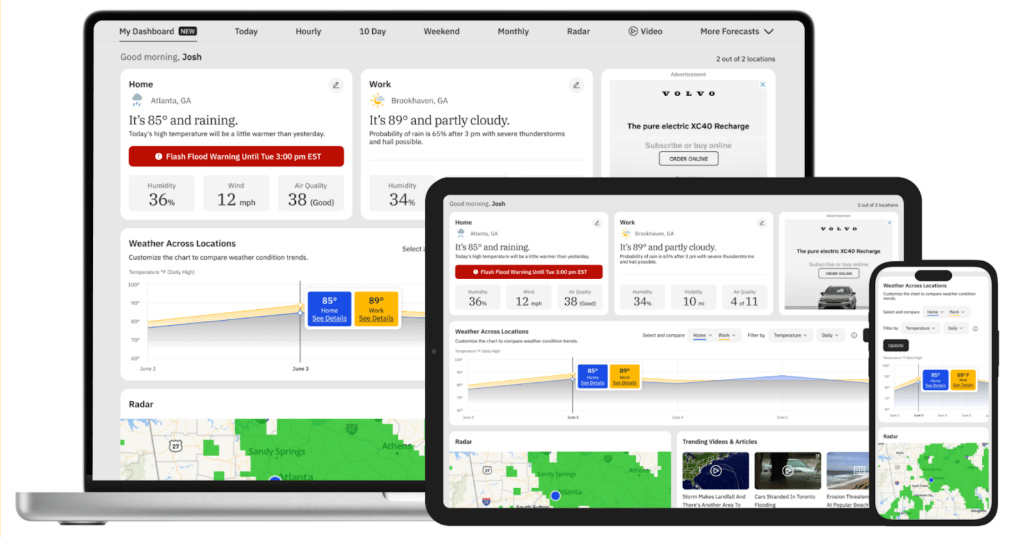For industries such as aviation, agriculture, and energy, weather forecasts aren’t trivial. They’re actually critical data that directly impact profits and safety.
Traditional forecasting models are often rigid, time-consuming, and heavily reliant on manual adjustments. However, AI tools are changing the game. AI weather forecasting tools analyze massive global datasets using artificial intelligence and predictive analytics, enabling them to deliver hyperlocal and real-time forecasts that keep operations running smoothly and risks under control.
Here’s our rundown of the best AI tools for weather forecasts.
The Weather Company: Best for enterprise-scale forecasting
The Weather Company is one of the largest weather intelligence providers worldwide, now operating as an independent firm following its acquisition by Francisco Partners from IBM in early 2024.
The company powers consumer brands such as Weather.com, Weather Underground, and The Weather Channel app, as well as enterprise-grade forecasting solutions used by major industries worldwide. Its platform leverages advanced algorithms, a proprietary technology that combines over 100 weather models, and the expertise of meteorologists, striking a balance between human and AI collaboration.
The Weather Company delivers over 25 billion personalized forecasts daily across more than two billion locations worldwide. This allows individual users to plan their days confidently, prepare for severe weather, and make safer travel choices. For businesses, The Weather Company provides accurate, real-time weather updates, forecasts, and historical data to support informed decision-making and seamless operations.
Companies can access hyper-local, historical hourly weather data and industry-leading accuracy through its Weather Data APIs. These APIs leverage advanced AI models and a Global High-Resolution Atmospheric Forecasting (GRAF) mode, providing scalable and actionable insights. For example, logistics teams use its APIs to reroute shipments ahead of severe weather, while energy companies depend on its forecasts to balance power supply and demand.
Tomorrow.io: Best for real-time weather intelligence and operational decisions
Tomorrow.io (formerly ClimaCell) is an AI-powered weather intelligence platform designed for businesses that need real-time forecasts.
From airlines and utilities to sports leagues and city planners, this platform converts atmospheric data into actionable insights that enable various industries to make informed, real-time decisions. Developers and businesses can integrate accurate and comprehensive weather data into their applications using Tomorrow.io’s free Weather Forecast API, enabling them to provide their users with valuable weather data insights.
Through its Historical Weather API, Tomorrow.io provides access to hourly and daily weather data from up to 20 years in the past, allowing businesses to analyze long-term climate patterns and trends. This historical data helps organizations understand seasonal variations, predict future conditions based on past patterns, and make informed, data-driven decisions for climate-sensitive operations, such as agriculture, logistics, and energy management.
What makes this AI weather prediction tool special is its recently released new FOCUS model, which sets a new industry standard for speed in storm forecasting. FOCUS is a machine learning model that delivers hyperlocal weather forecasts refreshed every 15 minutes, empowering communities and companies to make faster, smarter decisions in the face of extreme weather.
Unlike traditional models that update only a few times a day and require substantial computing resources, Tomorrow.io’s new model delivers storm-scale precision in real-time with minimal infrastructure.
Google WeatherNext: Best for AI-powered global climate model
Google’s WeatherNext is the latest evolution of AI weather forecasting from DeepMind and Google Research. Introduced in March 2025, this AI platform builds upon DeepMind’s earlier GraphCast model and uses enhanced AI and deep learning architectures to deliver faster, more accurate, and scalable forecasts.
Unlike traditional numerical weather models that rely solely on physics-based simulation, WeatherNext produces superior forecast reliability. It uses graph neural networks (GNNs) and transformer-based architecture to analyze decades of atmospheric data, taking into account patterns in pressure, wind, temperature, and moisture fields. This results in a system capable of producing a global 10-day forecast in under a minute, which significantly reduces the computational load.
WeatherNext includes two models: WeatherNext Graph, which provides more accurate and efficient forecasts best suited for single predictions, and WeatherNext Gen, which generates ensemble forecasts to help decision-makers better understand weather uncertainties and the risks associated with extreme conditions.
Bottom line: Smarter forecasting for a changing world
Weather forecasting platforms are transforming how organizations and communities plan for severe weather events, delivering timely and relevant information that helps people prepare and respond before disruptions occur.
The best AI weather forecasting tools are setting new standards for speed, accuracy, and actionable insights, helping organizations stay ahead of severe weather and operational risks. These models combine massive data with advanced algorithms to deliver critical forecasts that support smarter planning and resilience.
For an in-depth look at how AI is advancing climate forecasting, read AI for climate change. For a quick take on how machine learning is uncovering alarming climate patterns, see how AI pattern recognition signals disastrous Arctic climate change.
The post Best AI Tools for Weather Forecasts appeared first on eWEEK.

No Responses